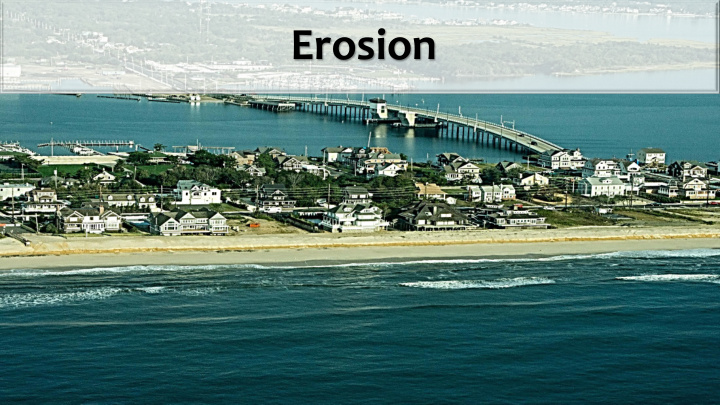



Erosion
Implications for New Jersey Chronic flooding issues Increased development pressure More frequent, higher intensity storm events Sea level rise Erosion Vulnerable Coastal Communities
How Does a Community Become Resilient to Coastal Hazards? • Create and Maintain Healthy Ecosystems • Healthy beaches and dunes • Stable shorelines • Healthy wetlands http://www.nj.gov/dep/cmp/czm_hazards.html
Stable Shorelines • Nature-Based Solutions • Alternatives to gray or hard armoring our coastlines (e.g., sea walls or bulkheads) (N.J.A.C. 7:7-6.24) • Examples: • Living Shorelines • Thin Layer Placement • Dredge Islands • Advantages: • Can break down wave energy during storms • May grow or adapt over time, which may enable these systems to keep up with rising sea levels (as opposed to walls and bulkheads, which weaken over time) • Provide co-benefits, such as habitat for wildlife and improvements to water quality
Healthy Wetlands Protect against flooding and storm damage • Wetland plants absorb the energy from storms • Every three miles of wetlands absorbs approximately one foot of storm surge Protect against erosion • The roots of wetland plants hold soil and sand in place so that the water does not take the soil or sand away with it Protect against global warming and sea level rise • Carbon dioxide traps heat close to the Earth • Too much carbon dioxide causes the Earth’s temperature to rise, which melts the polar ice caps and pushes more water into our oceans • Salt marshes take a lot of carbon dioxide out of the air. • Plants need carbon dioxide to grow • The types of plants found in coastal wetlands take in carbon dioxide very quickly and hold it for a long time
How Are We Ensuring NJ’s Coastal Communities Are More Resilient? • Work with Municipalities • Assess Community Vulnerability • Review and Assess Gaps in Local Regulations, Zoning, and Hazard Mitigation Planning • Provide Technical Assistance and Grants • Develop and Refine Data, Tools, and Guidance
Coastal Vulnerability Index • CVI mapping has been prepared for the entire coastal area in New Jersey covering 239 municipalities over four sea level rise scenarios: • 2014 • 2030 • 2050 • 2100 http://www.nj.gov/dep/cmp/czm_cvi.html
NJFRAMES Action Plan
NJFRAMES – What Are We Planning For?
NJFRAMES – Who is Involved? Municipalities
NJFRAMES – Constituents • Hackensack Meridian Health • Monmouth County Volunteer - Riverview Medical Center Society and Hazard Organizations Active in • Monmouth County Regional Disaster (VOAD)) Health Response Health Commission • SBP, Inc. • Monmouth Arts • Monmouth University Infrastructure • Naval Weapons Station Earle • NJAFM • American Littoral Society • EMACC - Eastern Monmouth Ecology and • Clean Ocean Action Economic Chamber of Commerce • Monmouth Conservation Habitat Development • Fair Haven Yacht Works / Foundation Marine Trades Association NJ • NY/NJ Baykeeper
NJFRAMES – Involved Agencies
NJFRAMES – Municipal Meetings
NJFRAMES – Next Steps
NJFRAMES – Project Website http://www.tworiversonefuture.nj.gov #TwoRiversOneFuture
Regional Resilience Planning Grant Program $15 million award to New Jersey • $10 million Regional Resilience Planning Grant Program • $5 million Toolkit 5-year program (September 2022) http://www.nj.gov/dep/oclup/resilientnj/index.html
Regional Resilience Planning Grant Program The Program will fund the development and implementation of up to 5 regional resilience and adaptation action plans. Planning • Regional scale Implementation • Risk/Vulnerability • Outreach & • Scenario-based education planning • Master plan • Cost benefit amendments analysis • Ordinances • Plan • Project design development • Bid documents • And more …
Regional Resilience Planning Grant Program Who Qualifies? • 9 HUD-identified MID counties • Groups of 3+ municipalities in those counties with a shared boundary • Utility authorities
Regional Resilience Planning Grant Program How will you benefit? • Assess vulnerability to coastal and riverine flooding • Identify locally and regionally-significant assets • Strategic and actionable mitigation • Implementation • Peer-to-peer sharing • Head start on future funding opportunities • Innovation
Regional Resilience Planning Grant Program Start Complete Outreach planning projects campaign phase Summer 2022 Spring 2018 Early 2019 Issue Start NOFA/RFP implementation phase May 21, 2018 Late 2020
Promoting Nature- Based Solutions http://www.nj.gov/dep/oclup/docs/bescch-final.pdf
Living Shorelines AGO http://www.nj.gov/dep/cmp/czm_mapindex.html
Living Shorelines AGO Living Shorelines Projects AGO
Updating FEMA Flood Maps for Sea Level Rise • There is an opportunity to include a Sea Level Rise Line directly on the FEMA FIRM map. • LUM and the Division of Dam Safety and Flood Control are supportive of this approach. • We have representatives that participate on a steering committee for the study on behalf of NJ. • The Division of Dam Safety and Flood Control is in discussions with FEMA on a cost estimate for incorporating SLR into the mapping analysis. • It is expected that the state would need to cover a majority of the cost of the modeling related to a separate Sea Level Rise Line.
Going Forward • Tough Conversations • Should we... ➢ Rethink how we build along our coastline? ➢ Change the type of development along our coast, working waterfronts (e.g., parks, marinas, restaurants, ecotourism, etc.)? ➢ Multi-residence housing on higher ground? ➢ Rolling easements?
Questions?
Recommend
More recommend